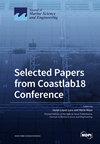Experimental and Simulation Study on Flow-Induced Vibration of Underwater Vehicle
IF 2.8
3区 地球科学
Q1 ENGINEERING, MARINE
引用次数: 0
Abstract
At high speeds, flow-induced vibration noise is the main component of underwater vehicle noise. The turbulent fluctuating pressure is the main excitation source of this noise. It can cause vibration of the underwater vehicle’s shell and eventually radiate noise outward. Therefore, by reducing the turbulent pressure fluctuation or controlling the vibration of the underwater vehicle’s shell, the radiation noise of the underwater vehicle can be effectively reduced. This study designs a cone–column–sphere composite structure. Firstly, the effect of fluid–structure coupling on pulsating pressure is studied. Next, a machine learning method is used to predict the turbulent pressure fluctuations and the fluid-induced vibration response of the structure at different speeds. The results were compared with experimental and numerical simulation results. The results show that the deformation of the structure will affect the flow field distribution and pulsating pressure of the cylindrical section. The machine learning method based on the BP (back propagation) neural network model can quickly predict the pulsating pressure and vibration response of the cone–cylinder–sphere composite structure under different Reynolds numbers. Compared with the experimental results, the error of the machine learning prediction results is less than 7%. The research method proposed in this paper provides a new solution for the rapid prediction and control of hydrodynamic vibration noise of underwater vehicles.水下航行器流动诱发振动的实验与模拟研究
在高速航行时,水流引起的振动噪声是水下航行器噪声的主要组成部分。湍流波动压力是这种噪声的主要激励源。它会引起水下航行器外壳的振动,并最终向外辐射噪声。因此,通过减少湍流压力波动或控制水下航行器外壳的振动,可以有效降低水下航行器的辐射噪声。本研究设计了一种锥-柱-球复合结构。首先,研究了流体-结构耦合对脉动压力的影响。然后,使用机器学习方法预测了不同速度下结构的湍流压力波动和流体诱发的振动响应。结果与实验和数值模拟结果进行了比较。结果表明,结构的变形会影响圆柱截面的流场分布和脉动压力。基于 BP(反向传播)神经网络模型的机器学习方法可以快速预测不同雷诺数下圆锥-圆柱-球体复合结构的脉动压力和振动响应。与实验结果相比,机器学习预测结果的误差小于 7%。本文提出的研究方法为水下航行器水动力振动噪声的快速预测和控制提供了一种新的解决方案。
本文章由计算机程序翻译,如有差异,请以英文原文为准。
求助全文
约1分钟内获得全文
求助全文
来源期刊

Journal of Marine Science and Engineering
Engineering-Ocean Engineering
CiteScore
4.40
自引率
20.70%
发文量
1640
审稿时长
18.09 days
期刊介绍:
Journal of Marine Science and Engineering (JMSE; ISSN 2077-1312) is an international, peer-reviewed open access journal which provides an advanced forum for studies related to marine science and engineering. It publishes reviews, research papers and communications. Our aim is to encourage scientists to publish their experimental and theoretical results in as much detail as possible. There is no restriction on the length of the papers. The full experimental details must be provided so that the results can be reproduced. Electronic files and software regarding the full details of the calculation or experimental procedure, if unable to be published in a normal way, can be deposited as supplementary electronic material.
 求助内容:
求助内容: 应助结果提醒方式:
应助结果提醒方式:


